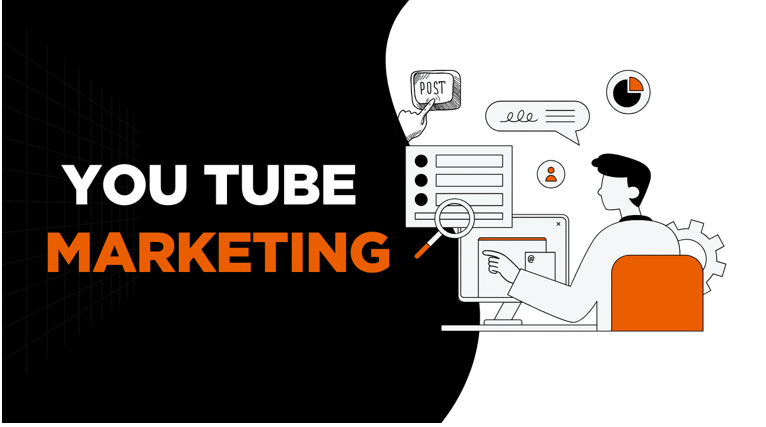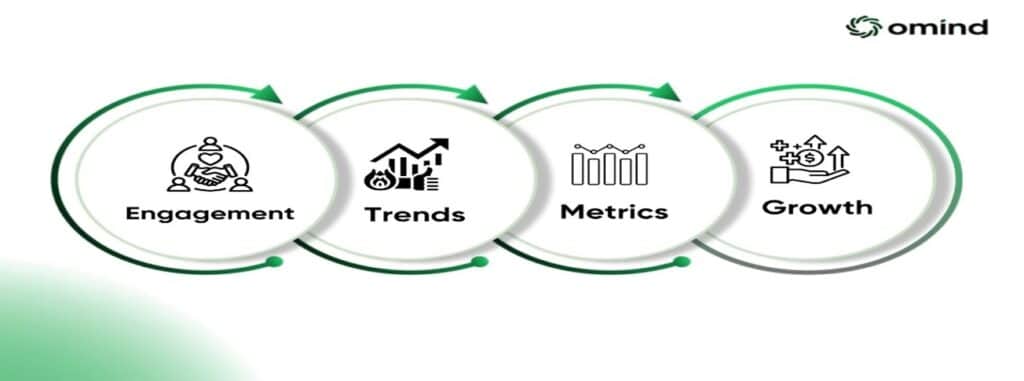
Table of Contents
ToggleWhat is YouTube Marketing and How Does It Work?
In today’s YouTube Marketing, video content has become a dominant force in online marketing. Among the various platforms available, YouTube stands out as a powerful tool for businesses and individuals alike. With over 2.5 billion monthly active users, YouTube offers unparalleled opportunities for brand exposure, audience engagement, and revenue generation.
In this comprehensive guide, we’ll delve into the intricacies of YouTube marketing, exploring its definition, benefits, strategies, and best practices to help you harness its full potential.
Understanding YouTube Marketing

YouTube marketing refers to the strategic use of YouTube’s platform to promote products, services, or personal brands through video content. This encompasses a range of activities, including:
- Creating and uploading engaging videos that resonate with your target audience.
- Optimizing video content for search engines to enhance visibility.
- Leveraging YouTube’s advertising options to reach a broader audience.
- Collaborating with influencers to tap into established communities.
- Analyzing performance metrics to refine strategies and improve results.
By integrating these elements, YouTube marketing enables businesses to build brand awareness, drive traffic, and foster customer loyalty.
The Mechanics of YouTube Marketing
To effectively implement a YouTube marketing strategy, it’s essential to understand how the platform operates and how users interact with content.
1.1 Content Creation and Optimization

Creating high-quality, relevant, and engaging video content is the cornerstone of successful YouTube marketing. This involves:
- Identifying your target audience’s interests and needs.
- Developing compelling video concepts that address those interests.
- Ensuring professional production quality, including clear audio and visuals.
- Incorporating strong calls-to-action (CTAs) to guide viewer behavior.
Optimizing your videos for search engines (YouTube SEO) is equally crucial. Key optimization practices include:
- Using relevant keywords in titles, descriptions, and tags.
- Creating eye-catching thumbnails to increase click-through rates.
- Adding closed captions and transcripts to enhance accessibility and SEO.
- Organizing content into playlists to encourage prolonged viewing sessions.
2.Leveraging YouTube Advertising
YouTube offers various advertising formats to help businesses reach their marketing goals:
- Skippable in-stream ads: Play before, during, or after videos; viewers can skip after 5 seconds.
- Non-skippable in-stream ads: Must be watched before the main video; typically 15-20 seconds long.
- Bumper ads: Non-skippable, 6-second ads designed for quick messages.
- Overlay ads: Semi-transparent ads that appear on the lower portion of a video.
- Display ads: Appear to the right of the feature video and above the video suggestions list.
By selecting the appropriate ad format and targeting options, businesses can effectively reach their desired audience segments
3. Collaborating with Influencers
Partnering with YouTube influencers allows brands to tap into established communities and gain credibility. Influencer collaborations can take various forms:
- Product reviews and demonstrations: Influencers showcase your product, highlighting its features and benefits.
- Sponsored content: Influencers create content that aligns with your brand message.
- Giveaways and contests: Encourage audience participation and engagement.
When selecting influencers, consider factors such as audience demographics, engagement rates, and content alignment with your brand values.
4. Analyzing Performance Metrics

Monitoring and analyzing your YouTube channel’s performance is vital for continuous improvement. Key metrics to track include:
- Watch time: Total minutes viewers have spent watching your videos.
- Audience retention: Percentage of a video watched by viewers.
- Click-through rate (CTR): Percentage of viewers who clicked on your video after seeing the thumbnail.
- Engagement metrics: Likes, comments, shares, and subscriber growth.
- Traffic sources: Understand where your viewers are coming from (e.g., search, suggested videos, external websites).
Utilizing YouTube Analytics provides insights into viewer behavior, helping you refine your content strategy and achieve better results.
Benefits of YouTube Marketing
Implementing a robust YouTube marketing strategy offers numerous advantages:
- Expanded Reach: Access to a vast global audience across various demographics.
- Enhanced Engagement: Video content fosters deeper connections with viewers.
- Improved SEO: YouTube videos often rank highly in Google search results.
- Cost-Effective Advertising: Flexible ad formats to suit various budgets.
- Measurable Results: Detailed analytics to track performance and ROI.
Best Practices for YouTube Marketing
To maximize the effectiveness of your YouTube marketing efforts, adhere to the following best practices:

1. Consistency is Key
Maintain a regular posting schedule to keep your audience engaged and signal reliability. Consistency helps build a loyal subscriber base and improves algorithmic favorability.
2. Focus on Quality Over Quantity
Prioritize creating high-quality content that provides value to your audience. Well-produced videos with clear messaging are more likely to resonate and be shared.
3. Engage with Your Audience
Respond to comments, ask for feedback, and encourage viewer interaction. Building a community around your channel fosters loyalty and enhances viewer retention.
4. Optimize for Mobile Viewing
Ensure your videos are mobile-friendly, as a significant portion of YouTube traffic comes from mobile devices. Use readable text, clear visuals, and concise messaging.
5. Stay Updated with Trends
Keep abreast of the latest trends and platform updates to stay competitive. Incorporate relevant topics and formats to maintain audience interest.
Conclusion
YouTube marketing presents a dynamic and impactful avenue for businesses and individuals to connect with audiences, build brand awareness, and drive conversions. By understanding the platform’s mechanics, leveraging its features, and adhering to best practices, you can craft a compelling YouTube marketing strategy that yields measurable success.
Remember, the key to thriving on YouTube lies in creating authentic, valuable content that resonates with your target audience. Stay consistent, engage with your viewers, and continuously refine your approach based on performance insights.
WhatsApp marketing is highly effective
Why WhatsApp Marketing Works
- Insane Open Rates
- WhatsApp messages have open rates as high as 98%, compared to email marketing which averages around 20-25%.
- Messages are usually read within minutes of delivery.
- Personalized Engagement
- WhatsApp is intimate and conversational. It’s perfect for building customer relationships, sending personalized offers, and offering real-time support.
- Voice notes, images, videos, catalogs — all make the interaction feel human and dynamic.
- Global Reach, Local Feel
- Over 2 billion users worldwide.
- Works great for both local businesses and global brands.
- Automation + Human Touch
- With WhatsApp Business API and tools like chatbots or CRM integration, businesses can automate replies, send updates, and still maintain a personal touch.
- Broadcasting & Group Messaging
- You can broadcast messages to a curated list of contacts, making it ideal for product launches, offers, and announcements.
- Unlike groups, broadcasts feel like 1-on-1 conversations (but scalable).
- High Conversion Rates
- Because it’s personal and trusted, WhatsApp campaigns often deliver higher ROI than email or social ads — especially in re-engagement and cart recovery.
Where WhatsApp Marketing Might Fall Short
- Limited scalability without WhatsApp Business API.
- Strict policies — you need opt-in from users before messaging.
- Cannot cold message new leads like email or ads.
- Broadcast list limits (256 contacts per list in the free app).
- Requires careful handling to avoid getting marked as spam.
Best Use Cases
- Customer support (fast, real-time help)
- Order confirmations & delivery updates
- Flash sales & exclusive deals
- Feedback & reviews
- Event reminders & registration confirmations
- Re-engaging inactive customers
- Lead nurturing with valuable content
Real-World Stats
- 80% of businesses report improved customer engagement after using WhatsApp.
- More than 60% of users feel more confident in purchasing when they can message a business directly.
Brands using WhatsApp automation have seen up to 20% boost in conversion rates
YouTube marketing refers to using YouTube as a platform to promote your business, products, or services. It involves creating and optimizing video content to engage your target audience, build brand awareness, and drive traffic to your website. Marketing strategies on YouTube include content creation, SEO optimization, paid ads, and collaboration with influencers.
To optimize your YouTube videos, follow these best practices:
Use keyword-rich titles, descriptions, and tags.
Create an engaging thumbnail to encourage clicks.
Include a compelling call to action in your video and video description.
Add relevant playlists and end screens to keep viewers on your channel.
Encourage likes, comments, and shares to increase engagement.
Ensure your video quality is high, as YouTube ranks videos with better engagement and retention rates.
Growing your YouTube channel involves a mix of strategies:
Consistency: Upload videos regularly to keep your audience engaged.
Quality content: Provide value through educational, entertaining, or informative videos.
Engagement: Respond to comments, ask questions, and foster a community.
Cross-promotion: Promote your YouTube channel on other social media platforms and your website.
Collaborations: Partner with influencers or other YouTubers in your niche to reach a wider audience.
YouTube Ads: Consider running YouTube ads to gain exposure to a larger audience.
YouTube ads work through Google Ads, allowing you to create video ads that play before, during, or after a YouTube video. There are several ad formats:
Skippable in-stream ads: Viewers can skip after 5 seconds.
Non-skippable in-stream ads: Must be watched before the video.
Bumper ads: 6-second non-skippable ads.
Display ads: Appear beside videos or on search results.
Overlay ads: Appear at the bottom of the video. Advertisers can target their audience based on factors like interests, location, demographics, and keywords to ensure their ads reach the right people.
